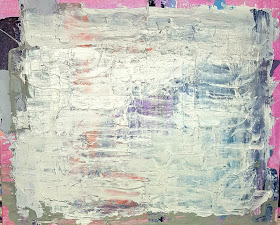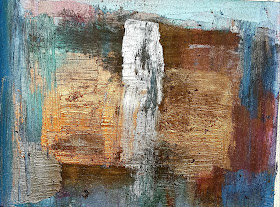Tuesday, February 27, 2018
Process - Update
So there was a post named "Process" a little while ago. This was where things stood at that time:
After a lot of tinkering, and revisiting, and my usual trick of layering and scraping, we finally have a finished product, and it looks like this:
After a lot of tinkering, and revisiting, and my usual trick of layering and scraping, we finally have a finished product, and it looks like this:
You can still see the middle, just about, but it's otherwise just about unrecognizable. Hard to imagine that we could have come so far from where we started, and ended up where we ended up, but that's what happens with painting, and what (mostly) makes it so interesting and fun. It's also what happens with so much of life, when you wonder to yourself, how on earth did I get here? I thought I was over there. I've been alive for a long-ish time and I still don't understand that dynamic. Anyway, this finished painting is now part of the Shape of Water series I posted about recently, for what it's worth, and it's called Walk Out to Winter.
Sunday, February 25, 2018
The Shape of Water
Sometimes I get on a roll with a certain theme. Lately things have been winter-and-related. This set, done in the last couple of days, are mostly about water and winter and Herzschmerz and Weltschmerz.
Walk Out to Winter
Waterwall
Frozen Water, Hidden Minerals
Ocean Rain
Remembering That Sunset
Friday, February 23, 2018
Nightingale/Meditation/Mutation
I am about to teach a lot of poems about birds, for some reason, I think perhaps to spend some time focusing on the function of metaphor? Anyway, the first of these is Keats' "Ode to a Nightingale," which is a weirdass poem. Speaking of weirdass, a couple of months ago I decided to make a painting that had words in it, in the form of a very loose meditation/poem of some philosophical and spiritual desperation, as follows:
Where is my beautiful colour?
Where is my perfect thought?
Where is my clear mind?
It was a nightingale.
It was a nightingale.
I have since partially obscured part or all of some of those words, to make the meditation , and the nature of the struggle as well perhaps, more elusive, perhaps like the bird itself. Here is what happened when I did that:
I like that the words are now obscured, and not only because I'm embarrassed by my script. The suggestion of words is sometimes much more interesting than the words themselves, and I've been in mind of Frank O'Hara's "Why I Am Not A Painter" lately, along with all of those sardines that may or may not have shown up. And now the questions about the beautiful color, the perfect thought, and the clear mind are embedded in the painting itself, which seems appropriate. Questions buried, answers buried, meanings obscured. Yes, yes, and yes.
Process II
Here's another look at something that turned into something else, quite unexpectedly, and what happens when you keep messing with what you think is already finished. Somewhere during the depths of winter when I was bored, as I often am, I just started daubing paint on whatever surface I had to hand. I had no plan, as I rarely have a plan; I just wanted to see what would happen if I put certain colors up against certain other colors and then where it might lead. This is where is went initially:
Clearly I must not have been satisfied with that, because after an indeterminate amount of time, probably so that it could dry, I then did this to it:
And by "this," I mean a few things. Obviously I painted over what has now become the base of the painting, and then scraped away at that top layer. You can still see some of the original stuff underneath, but it's getting harder to detect. I also added some copper paint in the center, and a messy white stripe down the middle of that. And then I did something really weird. I added dirt. Yes, dirt. Those little bits and specks you see there? That's dirt. Because I think I realized at a certain point that I was going for something truly elemental, and because the paint was still wet so it would literally allow me to throw stuff at it. I think I ended up calling this one "Precious Metals." I like it. I think I also included it in one of the imaginary flag posts somewhere else on this blog.
So that's all fine and good. But then I kept looking at the image I had captured and then looking at different aspects of it, and I started to zero in on sectors of the painting. So I started to take photographs of them, and narrow it down some more. It becomes more granular, and almost magically starts to create new micro-paintings from the larger original. Like these:
So, lessons in layers, texture, and segmenting. Painting is fun, and there are absolutely no rules. Except don't be afraid. That's a rule.
Thursday, February 22, 2018
Process
Nothing is ever over, if you're a certain kind of person. One of the things I've learned about painting (and one of those things is not how to actually paint, ha ha), is deciding when something is actually done and finished. My general rule of thumb is that, if I can visualize it in a frame, then I can usually stop. Some paintings come right out and they're ready, almost like magic. Others seem like a total disaster and I wonder what to do with them, and I just keep painting over and over, scraping and worrying at them until I discover what I was looking for. And some just hang around, waiting for me to come back to them when the time is right. Here's one I've been working on for a little while:
This isn't what it looked like originally. At first it looked like this:
And I hated it. So I just covered it up. Then it looked like this:
I still hated it, so I added more cover up. The first one in the sequence is what it looks like now. I still don't like it, and I'm sure I'll keep adding to it. I have some ideas. But what's interesting is what happens if you take the digital image and zoom in on some of the parts you do like and extract them into their own stand-alone images. I'm sure there's a word for this, but I don't know what it is. Here, for example, is one segment:
Isn't that much better? And here are some others:
I like all of these a lot, and I may just make them into prints, while I continue to mess with the original template in real life. Of course, everything is over eventually, but some things never quite feel over. Painting allows for that process to play out without any consequences except a continuing unveiling of what it is that I was trying to say, and sometimes the answers are quite surprising.
States of Vital Exhaustion
There is, apparently, a name for the bone-muscle-and-soul-eroding lassitude I have felt for the last several years, for reasons too numerous to list, the kind of brokenness that cannot be explained in the same way that it is experienced, the kind of brokenness we think we are approaching, while not realizing that it has already happened, the kind of brokenness that is deeply damaging to every aspect of life, to harmony, to peace, to sanity, to physical and emotional heart health, really to everything that is fundamentally important for a life of wholeness and integrity. According to this article in The Guardian, we can actually hit a wall of fatigue, stress, anxiety, and grief that amounts to complete burnout or, as they have it, a "state of vital exhaustion."
https://www.theguardian.com/society/2018/feb/21/how-burnout-became-a-sinister-and-insidious-epidemic
Here is what that looks like once it comes out of my utterly exhausted heart, soul and brain, and onto a piece of painted material. States of vital exhaustion, in living color:
https://www.theguardian.com/society/2018/feb/21/how-burnout-became-a-sinister-and-insidious-epidemic
Here is what that looks like once it comes out of my utterly exhausted heart, soul and brain, and onto a piece of painted material. States of vital exhaustion, in living color:
Wednesday, February 21, 2018
Tuesday, February 20, 2018
Argument
I am rather strangely preoccupied with ekphrasis, and equally but less strangely preoccupied with the poet Elizabeth Bishop. This is my attempt to paint one of her poems. My fondest artistic aspiration is to put on a show one day that hangs poems next to paintings. Perhaps it will be called "Ekphrasia." Or not.
Days that cannot bring you near
or will not,
Distance trying to appear
something more obstinate,
argue argue argue with me
endlessly
neither proving you less wanted nor less dear.
"Argument," Elizabeth Bishop
(Acrylic, 9x12)
Saturday, February 17, 2018
3 Shades of Grey
Update: none of these looks like this now. I've even lost track of how they turned out. This is what happens in the winter. Snow falls on snow, then it melts, then it snows again, and so on, until you want to hurt yourself. That's what it's like in New England anyway.
Valentines
Because Valentine's Day is stupid and littered with emotional carnage and an overwhelming amount of inauthentic cheese and not great candy, here are some twisted Valentines for the Resisters who may be the right kind of Romantics after all. All of the hearts are buried and scarred, just the way they are in real life. Enjoy.
Thursday, February 15, 2018
Flags III
(i do not know what it is about you that closes and opens;only something in me understands the voice of your eyes is deeper than all roses) nobody,not even the rain,has such small hands
Saturday, February 10, 2018
Commission
My sister wanted some paintings. She gave me some color combinations. I made some stuff. Here they are.
Grenfell Tower
I saw a photo in the New York Times of the defective protective cladding on apartment buildings/blocks of flats where ordinary working class people live. One of those buildings was Grenfell Tower in London, where an enormous number of people died in a fire last year. The NYT photograph struck me for several reasons. First, it was stripped of its humanity, and also at the same time exposed. Second, it consisted of a series of colorful panels in an urban wilderness, panels that seemed to stand in for the entire spectrum of humanity that had lived there. Third, it reminded me of the weird rectangular blocks I painted last year to represent my impressions of Maine last year. So I did some paintings based on that.
Put Out More Flags
Some of the more recent nonsense. I’m trying to change, but change is hard. Sometimes I think I should stick to the good formula, but I also want to grow. Lessons in life. I have tried to do some new things. I have also had a longstanding interest in the connection between poetry and painting. Lastly, I adore the poetry of Elizabeth Bishop, whose poem “The Monument” is very important to me. These aren’t monuments, but they are signals of loyalty to imaginary countries. I wonder if Bishop’s poem wasn’t such a signal too. Here are some flags. Perhaps one of them represents your emotional country.


















































